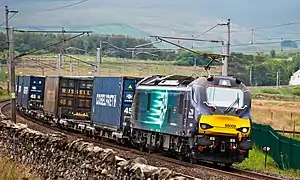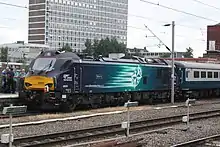British Rail Class 88
The Class 88 is a type of mixed traffic electro-diesel locomotive manufactured by Stadler Rail for Direct Rail Services in the United Kingdom. The design is part of the Stadler Euro Dual family.
| British Rail Class 88 | |||||||||||||||||||||||||||||||||||
|---|---|---|---|---|---|---|---|---|---|---|---|---|---|---|---|---|---|---|---|---|---|---|---|---|---|---|---|---|---|---|---|---|---|---|---|
 88009 at Scout Green going towards the Shap Summit | |||||||||||||||||||||||||||||||||||
| |||||||||||||||||||||||||||||||||||
| |||||||||||||||||||||||||||||||||||
| |||||||||||||||||||||||||||||||||||
| |||||||||||||||||||||||||||||||||||
Background
In January 2012, Direct Rail Services announced that it had ordered a total of 15 new diesel locomotives from Vossloh España (now Stadler Rail). These locomotives, which entered service in the UK as Class 68, were part of Vossloh's Eurolight family, redesigned to fit the smaller UK loading gauge.[1]
In September 2013, DRS announced that it was procuring a further ten locomotives. Unlike the Class 68s, these new units would be electro-diesel locomotives, capable of operating either via OHLE, or by using an onboard diesel engine. However, the new locomotives would feature the same bodyshell, cab, brakes, bogies, traction equipment and control software as the Class 68.[2] The new locomotives were announced as being Class 88.[3]
The first locomotive, no. 88 002, was delivered to the UK via the Port of Southampton and was transferred by road to the Carlisle Kingmoor TMD in January 2017.[4] They entered service in July 2017.[5]
Specification
The Class 88 is part of the Stadler Euro Dual family. This is a range of dual-mode locomotives that are fitted both with a pantograph, to collect electricity from overhead wires, and a Caterpillar diesel engine. The UK version is able to run either on electrified lines using the pantograph, which is the UK's standard OHLE current at 25 kV AC, or away from electrified lines with the Caterpillar C27 950 hp (710 kW) engine.[6] Dual-mode locomotives have previously been mooted for freight use in the UK, using the "Last Mile" principle, where a primarily electric locomotive is fitted with a small diesel engine to allow locomotives to run without a load to non-electrified freight sidings.[7] However, the Class 88 is a fully dual-mode locomotive, with the diesel engine powerful enough to haul a train on its own, although with only 17.5% of the power it would otherwise have in electric mode.[8] The Class 88s are the first dual-mode locomotives in the UK to use the 25 kV AC electrification, as the only other electro-diesel locomotives to have entered service on the British network were the Class 73 and Class 74, which operated in the Southern Region using third rail electrification.[9]
Operation
.jpg.webp)
Direct Rail Services has procured the Class 88 to serve as a mixed-traffic locomotive, capable of operating both passenger and freight services.[8] Primarily they are used to enable DRS to haul freight using electric locomotives without the need to hire in electric traction from other operators.[9] The class is almost entirely confined to Daventry - Mossend intermodal traffic and nuclear flask trains across the north of England and Scotland. However, as with the Class 68, they are also capable of operating passenger trains.
Named locomotives

All of the Class 88 locomotives have been named, with seven of the ten locomotives reusing names from the 1950s vintage Class 77s, later sold to the Netherlands as NS Class 1500, while one locomotive (88002) bears the name of a former Class 76 locomotive.
Fleet details
| Class | Operator | No. Built | Year Built | Loco nos. |
|---|---|---|---|---|
| Class 88 | Direct Rail Services | 10 | 2015–16 | 88001–88010 |
References
- "Direct Rail Services orders 15 Vossloh EuroLight UK locomotives". Railway Gazette International. 5 January 2012.
- "Beacon Rail and DRS order dual-mode locos", www.modern-railways.com, 12 September 2013
- "DRS orders ten dual-mode Class 88s" Rail issue 731 18 September 2013 page 7
- Harris, Nigel, ed. (1 February 2017). "Direct Rail Services' first '88' arrives in UK". Rail Magazine. No. 819. Peterborough: Bauer Media. p. 15. ISSN 0953-4563.
- "FIRST REVENUE-EARNING FREIGHT FOR DRS CLASS 88".
- Nicholls, Mark, ed. (March 2018). "Stadler's Revolutionary Class 88". Railways Illustrated. Vol. 16 no. 3. Stamford: Key Publishing. p. 38. ISSN 1479-2230.
- "Bombardier launches Traxx electro-diesel". Railway Gazette International. 10 May 2011. Archived from the original on 12 May 2011. Retrieved 12 February 2016.
- Johnson, Marc (1 April 2014), "Sleek Lines", www.therailengineer.com, retrieved 12 February 2016
- Briginshaw, David (25 September 2014). "Electro-diesel locomotive debuts at InnoTrans". International Railway Journal. Retrieved 12 February 2016.
- Devereux, Nigel (15 March 2017). "DRS Class 88s to revive Woodhead electric names". The Railway Magazine. Retrieved 16 June 2020.
- Milner, Chris, ed. (July 2020). "Track Record". Railway Magazine. Vol. 166 no. 1, 432. Horncastle: Mortons Media. p. 53. ISSN 0033-8923.
External links
- Report of launch event (includes photo)
| Wikimedia Commons has media related to British Rail Class 88. |